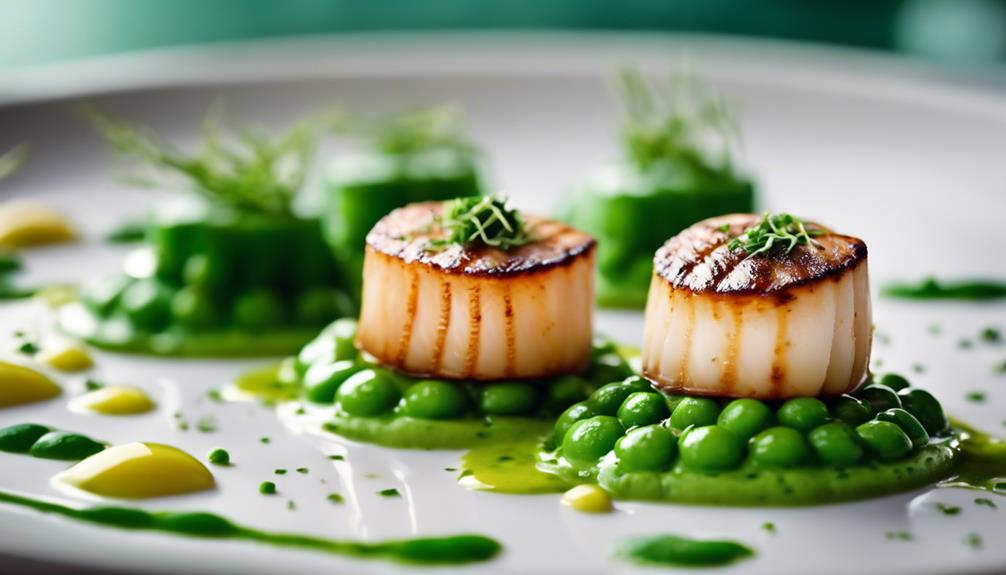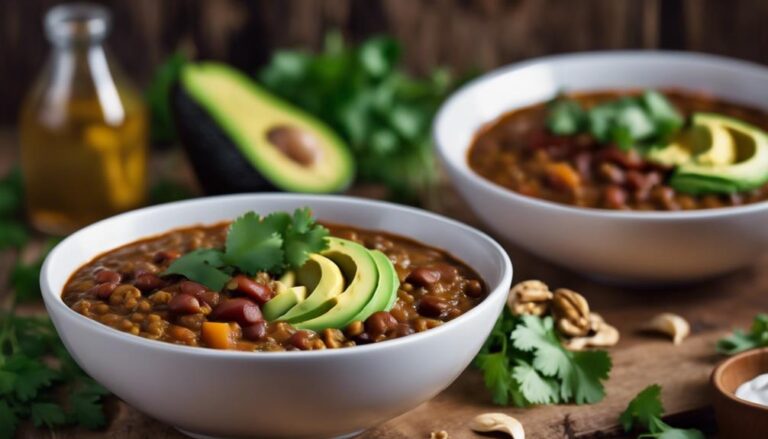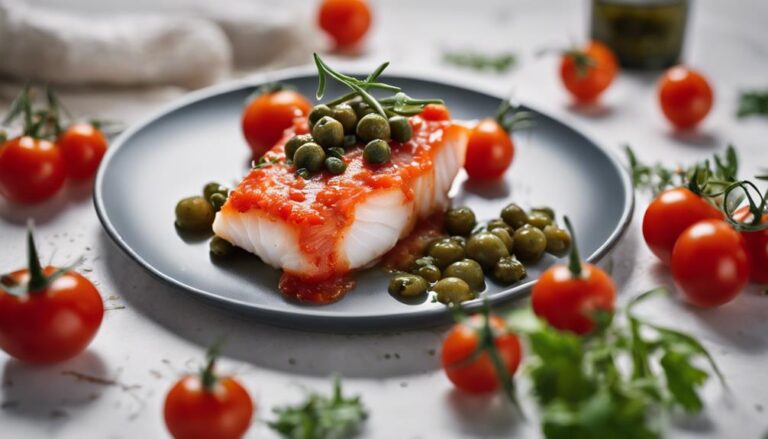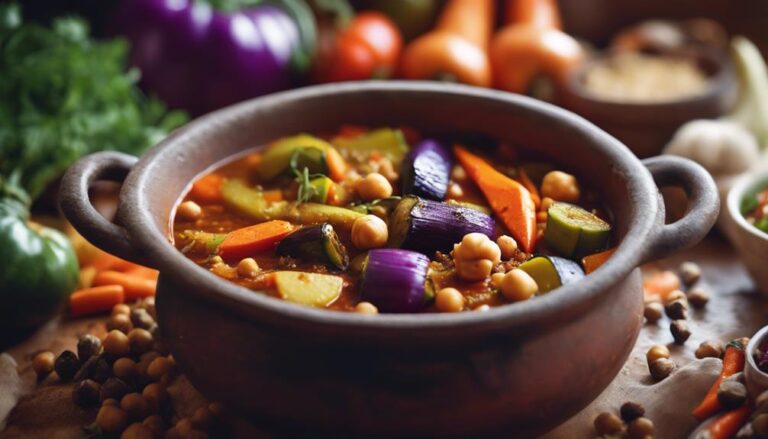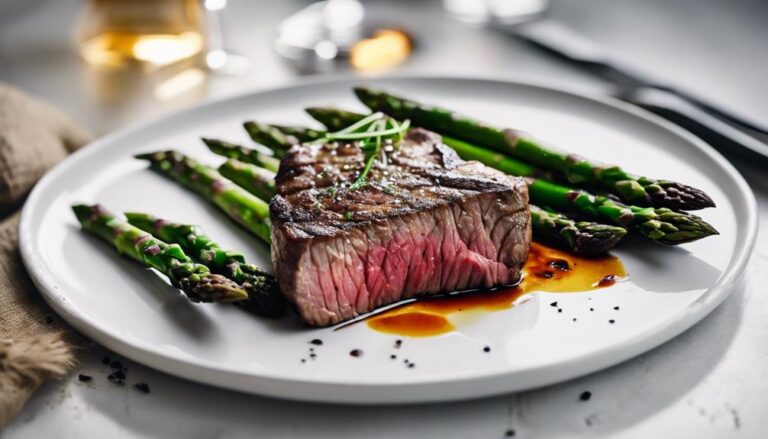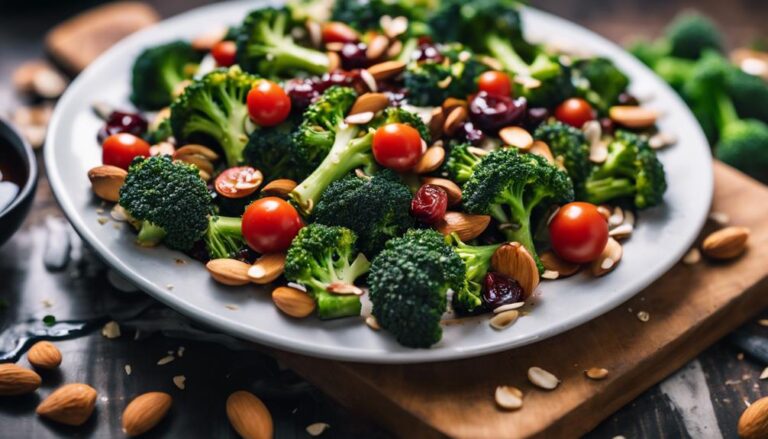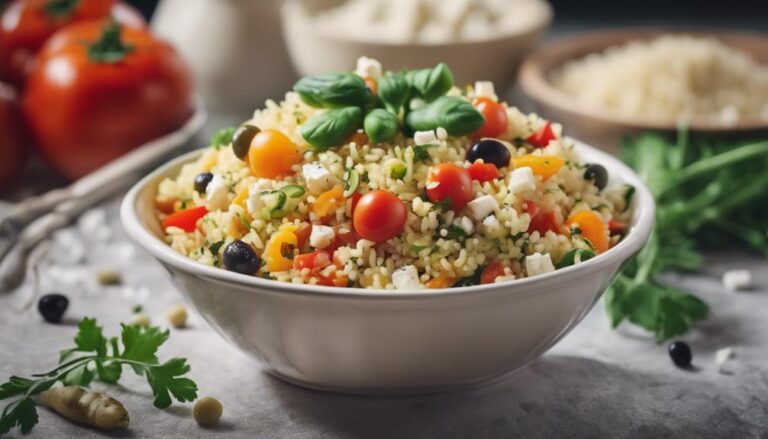Sous Vide Seared Scallops With Pea Puree
Achieve culinary perfection with sous vide seared scallops and pea puree. Enhance flavors by sealing ingredients for an exquisite dining experience. Sear scallops to a golden crust by properly managing heat control and using a quick sear technique. Pat dry scallops before searing to guarantee ideal texture. Elevate your dish with herbs, lemon zest, and butter. Consider pea puree to complement the scallops' natural sweetness. Experiment with various garnishes for a vibrant presentation. Uncover the secrets to mastering this sophisticated dish and tantalize your taste buds with each bite. Enhance your cooking skills with this delightful combination.
What You Will Learn Here
- Sous vide ensures perfectly cooked scallops with tender texture and enhanced flavor.
- Seared scallops complemented by vibrant pea puree create a delicious dish.
- Proper searing technique on high heat yields a golden crust on scallops.
- Use fresh herbs, lemon zest, and butter to elevate the taste profile.
- Presentation with microgreens or olive oil enhances the visual appeal of the dish.
Culinary Evolution: Sous Vide
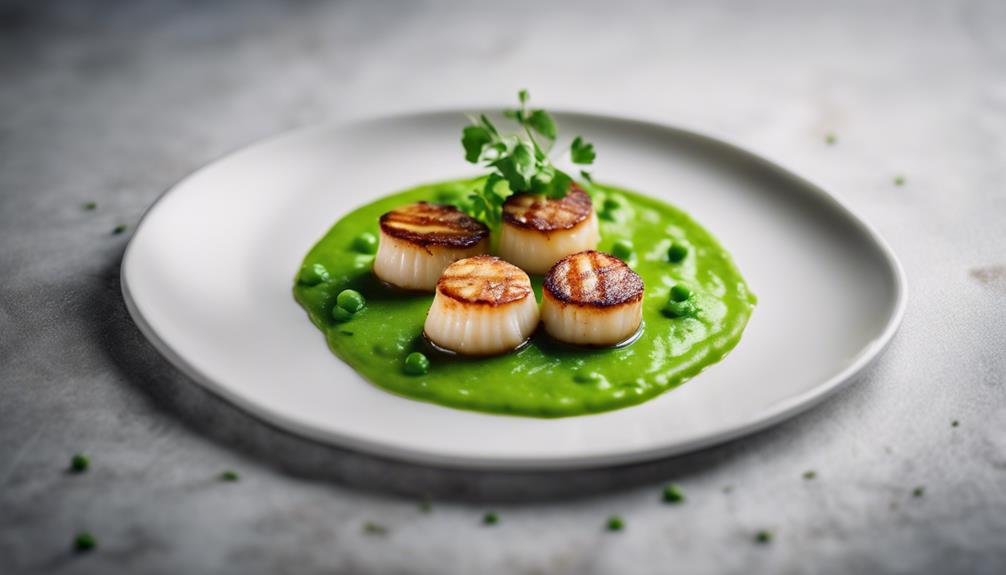
Sous vide has revolutionized cooking by offering precise temperature control, ensuring your food is cooked exactly as you desire.
This method enhances flavors by sealing ingredients in airtight bags, preserving their natural juices and aromas.
The evolution of sous vide has brought a new level of culinary sophistication to home kitchens and professional settings alike.
Sous Vide Basics
Exploring the evolution of culinary techniques, one method that has gained popularity for precision cooking is sous vide. Sous vide, meaning 'under vacuum' in French, involves cooking food in a vacuum-sealed bag at precise temperatures in a water bath. This method offers unparalleled temperature control, guaranteeing that your food cooks evenly from edge to edge.
Temperature control is essential in sous vide cooking as it allows you to cook your ingredients to the exact doneness you desire. By setting the water bath to a specific temperature, you can achieve consistent results every time. Additionally, sous vide provides the flexibility to cook various foods for extended periods, allowing tough cuts of meat to become tender while preserving their natural flavors.
When it comes to cooking times, sous vide offers the advantage of being forgiving. Since the food is cooked gently at a controlled temperature, it's less likely to overcook, giving you a larger window of time for completion. This precision in cooking times ensures that your dishes come out perfectly cooked, making sous vide a valuable technique for home cooks and professional chefs alike.
Cooking Precision
For chefs seeking unparalleled cooking precision, the sous vide method offers a revolutionary approach to achieving consistent results. Temperature accuracy is a key feature of sous vide cooking. By cooking your ingredients at a precise temperature in a water bath, you can guarantee they reach the exact level of doneness you desire. This method also allows for precise control over cooking time, resulting in perfectly cooked dishes every time.
Equipment precision plays an essential role in sous vide cooking. Sous vide machines maintain a constant water temperature, making sure that your food cooks evenly. Vacuum-sealed bags keep the ingredients submerged in the water bath, allowing for uniform cooking. This level of precision is what sets sous vide apart from traditional cooking methods.
When it comes to texture perfection, sous vide shines. The gentle cooking process preserves the natural juices and flavors of the ingredients, resulting in tender and succulent dishes. With sous vide, you can achieve restaurant-quality textures in the comfort of your own kitchen.
Flavor Retention
Achieving peak flavor retention is a hallmark of the culinary evolution brought about by sous vide cooking. Sous vide cooking excels in flavor preservation by sealing ingredients in airtight bags, allowing them to cook in their own juices. This method guarantees that no flavor is lost during the cooking process, resulting in incredibly rich and intense taste profiles. Additionally, the precise temperature control in sous vide cooking helps enhance textures by breaking down tough connective tissues while maintaining the natural moisture of the ingredients.
When you cook scallops sous vide, you seal in their delicate sweetness and briny essence, creating a succulent and tender mouthfeel that's unmatched by other cooking methods. The gentle cooking process ensures that the scallops retain their plumpness and juiciness, providing a luxurious dining experience. Pairing the perfectly cooked scallops with vibrant pea puree only amplifies the flavors, creating a harmonious blend of textures and tastes that will tantalize your taste buds. Sous vide cooking truly revolutionizes flavor retention, making every bite a culinary delight.
Scallop-Enhancing Ingredients
To enhance the flavor of your scallops, consider incorporating a blend of aromatic herbs and a splash of citrus juice. When preparing your scallops, here are some scallop-enhancing ingredients to take your dish to the next level:
- Fresh Herbs: Chopped parsley, thyme, or chives can add depth and freshness to the scallops.
- Garlic: A hint of minced garlic can complement the natural sweetness of the scallops.
- Lemon Zest: Grated lemon zest brightens the dish with a burst of citrusy flavor.
- Butter: A small pat of butter can enrich the scallops and create a luxurious texture.
These ingredients can elevate the taste profile of your scallops, enhancing their natural sweetness and delicate texture. Experiment with different combinations to find your favorite flavor pairing.
Scallop and Herb Risotto
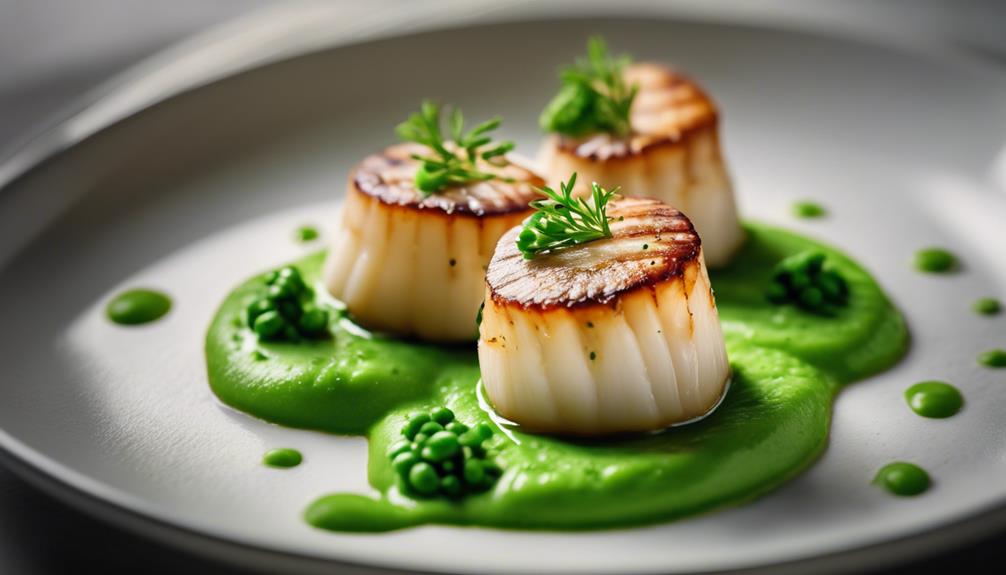
When it comes to creating a flavorful Scallop and Herb Risotto, you can enjoy the creamy texture of the rice combined with the delicate taste of the scallops.
For a twist, consider trying out Scallop and Bacon Skewers that offer a perfect balance of savory and smoky flavors.
If you're hosting a gathering, Bacon-wrapped Scallop Bites make for an impressive appetizer that will surely delight your guests.
Savory Scallop Risotto Recipe
Incorporate fresh scallops into a delightful herb-infused risotto for a savory culinary experience. This Scallop and Herb Risotto recipe combines the delicate flavor of scallops with the richness of a well-prepared risotto.
Here are some tips to perfect this dish:
- Select Fresh Ingredients: Choose high-quality scallops and fresh herbs for the best flavor.
- Master Risotto Textures: Achieve a creamy yet slightly al dente texture by adding warm broth gradually and stirring constantly.
- Infuse with Herbs: Elevate the dish by adding a mix of fresh herbs like thyme, parsley, and chives for a burst of flavor.
- Seared Scallop Finish: For a beautiful presentation and added texture, sear the scallops in a hot pan before placing them on top of the risotto.
Scallop and Bacon Skewers
For a delightful twist on the Scallop and Herb Risotto, consider preparing Scallop and Bacon Skewers for a flavorful combination of seafood and smoky bacon. These skewers offer a unique way to enjoy grilled scallop variations with a touch of savory bacon. Here are some ideas to enhance your seafood pairing experience:
- Alternate Ingredients: Experiment with different types of bacon like maple or applewood smoked for varied flavors.
- Vegetable Medley: Thread cherry tomatoes and bell peppers between the scallops for added color and taste.
- Marinade Magic: Try marinating the scallops in a mixture of garlic, lemon juice, and herbs before skewering for an extra burst of flavor.
- Grilling Tips: Make sure the bacon is partially cooked before assembling the skewers to prevent uneven cooking.
These Scallop and Bacon Skewers aren't only visually appealing but also a delicious option for a summer barbecue or a special dinner. Get creative with your seafood pairing ideas and enjoy this delightful dish with friends and family.
Bacon-wrapped Scallop Bites
Indulge in the delightful combination of savory bacon-wrapped scallop bites, paired with a flavorful herb risotto. The crispy bacon wrapping the tender scallops creates a perfect blend of textures, while the creamy herb risotto adds a comforting richness to this dish.
Here are a few key points to know about this tasty appetizer:
- Flavorful Presentation: The golden-brown bacon-wrapped scallops, served on a bed of vibrant green herb risotto, make for a visually stunning dish that's sure to impress your guests.
- Perfect Bite-sized Portions: These bacon-wrapped scallop bites are ideal for serving as an elegant appetizer at dinner parties or special occasions.
- Balanced Flavors: The salty bacon complements the sweet scallops, while the herby risotto adds a fresh and aromatic element to each bite.
- Easy to Prepare: Despite its gourmet appearance, this dish is simple to make, allowing you to enjoy a restaurant-quality appetizer in the comfort of your own home.
Searing Scallops Perfectly
To sear scallops perfectly, make sure you control the heat properly to achieve a golden crust.
Remember to pat dry the scallops before searing to remove excess moisture, allowing for a better sear.
Use the quick sear technique for a delicious caramelization without overcooking the delicate scallops.
Proper Heat Control
Achieve perfect searing on your scallops by mastering the art of proper heat control. Temperature control is key when searing scallops. Make sure your pan is hot enough to create a beautiful crust but not so hot that it burns the delicate meat. Heat management is essential; a medium-high heat setting is usually ideal.
Use a high smoke point oil like canola or grapeseed to prevent burning. Searing technique matters too; pat your scallops dry before placing them in the hot pan to avoid excess moisture interfering with the sear. Cooking precision is vital; sear each side for about 1-2 minutes or until a golden-brown crust forms. Avoid overcrowding the pan to maintain the heat levels.
Pat Dry Scallops
Mastering the art of searing scallops begins with making sure you pat them dry before they hit the hot pan. Scallop preparation is vital for achieving the perfect sear and texture contrast. By removing excess moisture from the scallops, you allow them to develop a beautiful caramelized crust when they hit the hot surface, enhancing their flavor profile.
Patting the scallops dry with a paper towel before cooking helps to prevent steaming and promotes better browning. This step is essential in creating that sought-after contrast between the crispy exterior and tender interior of the scallop. Properly dried scallops also absorb seasoning more effectively, enhancing their overall taste.
To pat dry scallops, place them on a paper towel-lined plate and gently press another paper towel on top to absorb any moisture. Make sure both sides are thoroughly dried before seasoning and searing them in a hot pan. Taking the time to properly prepare your scallops will elevate your dish, creating a delightful combination of flavors and textures that will impress your palate.
Quick Sear Technique
For a quick sear technique that guarantees perfectly cooked scallops, start by heating a skillet over high heat. The ideal sear temperature for scallops is around 400-450°F (204-232°C).
Once the skillet is hot, add a thin layer of oil with a high smoke point like canola or grapeseed oil. Place the scallops in the skillet, making sure not to overcrowd them to guarantee an even sear. Let the scallops sear without moving them for about 1-2 minutes. This initial searing time allows the scallops to develop a beautiful golden crust on one side.
After the first side is seared, gently flip the scallops using tongs and sear the other side for an additional 1-2 minutes. The total searing time for scallops is typically 2-4 minutes, depending on their size.
Be cautious not to overcook the scallops, as they can quickly become rubbery. Once both sides are caramelized to perfection, remove the scallops from the skillet and serve immediately for a delightful dining experience.
Final Thoughts
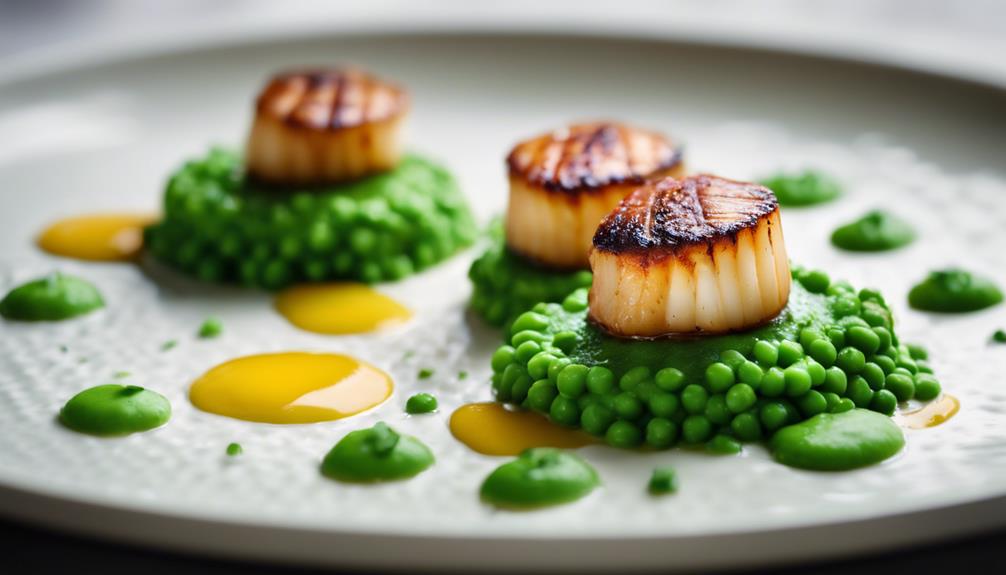
Considering all the elements of this dish, your Sous Vide Seared Scallops With Pea Puree is sure to impress both your taste buds and your guests. The benefits of using sous vide cooking for the scallops are evident in the tender texture and enhanced flavors that are sealed in during the precise cooking process. The gentle cooking method ensures that the scallops remain juicy and flavorful, creating a delightful bite every time. Paired with the vibrant and velvety pea puree, the dish offers a harmonious balance of flavors that will tantalize your palate.
When it comes to pea puree variations, you can get creative by adding different herbs like mint or basil to elevate the taste profile. Additionally, consider experimenting with adding a touch of lemon zest for a rejuvenating twist. For presentation ideas, serving the scallops atop a dollop of pea puree and garnishing with microgreens or a drizzle of quality olive oil can elevate the visual appeal of the dish, making it a feast for both the eyes and the taste buds. Enjoy your culinary creation!
Frequently Asked Questions
Can Frozen Scallops Be Used for This Recipe?
Yes, you can use frozen scallops for this recipe, but fresh ones are recommended for better flavor. When using frozen scallops, make sure they are properly thawed before sous vide cooking. Follow sous vide tips for best results.
What Other Herbs Can Be Used Besides Thyme?
For a different taste in your scallops, besides thyme, consider using rosemary or basil. Enhance them with lemon and garlic for added flavor. These herb and seasoning combos can elevate your dish beautifully.
Is It Necessary to Use Fresh Peas for the Puree?
You don't have to use fresh peas for the puree. Canned peas work well too. For variations, try mint for freshness or basil for a more herbal flavor. Experiment with different options to suit your taste.
Can the Scallops Be Seared in a Grill Pan?
You can definitely sear the scallops in a grill pan for a tasty twist. While it may alter the texture slightly, it adds a delicious charred flavor. Consider other methods like broiling or pan-searing too. Store leftovers in an airtight container.
How Long Can the Pea Puree Be Stored in the Fridge?
To store pea puree in the fridge, make sure it's in an airtight container, use within 3-4 days for best freshness. Add lemon zest or mint for flavor variations. Reheat gently on the stove or microwave for quick meal prep.
Conclusion
To sum up, sous vide seared scallops with pea puree offer a delightful combination of flavors and textures. By utilizing the sous vide method, the scallops are cooked to perfection, ensuring a tender and juicy result every time.
The pea puree adds a vibrant pop of color and freshness to the dish, enhancing the overall dining experience. With a few simple steps, you can create a restaurant-quality meal in the comfort of your own kitchen.
Enjoy the culinary journey!
